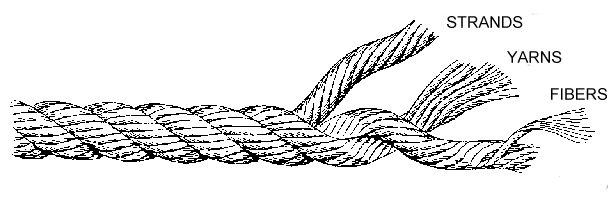- Making rope is a skill that has been around
for thousands of years. Once people got past vines and other natural materials
for binding up things, they discovered that fibers could be combined and
twisted into great lengths by taking advantage of the tendency of materials
to remember their natural condition. The example below of a laid rope of
three strands is a right hand lay which is the most often encountered form
of laid rope. Laid ropes with the opposite twist pattern are said to be
left hand laid. The lay of a rope is determined by examining the twist.
If you look down the length of a rope and the primary strands spiral in
a clockwise direction, it is right hand laid.

- One method of making a laid up rope (a
requirement for the Pioneering merit badge) is to do the twisting by hand.
Simple mechanical methods for making rope are described in "Knots
and How to Tie Them", (a BSA booklet available at the Scout Shop).
- Making rope without any special tools requires the hands of a few Scouts
to accomplish. While the rope may not be factory quality stuff, it does
clearly illustrate the principles involved.
The recipe:
1. Obtain a length of sisal , jute or any other twisted fiber twine.
2. Examine the twist of the twine to determine the direction of the twist already present. This twine will form the strand as illustrated above.
3. Cut three equal lengths (whatever you think your boys can work with --- although initially 10 feet should suffice).
4. Tie a small loop in one end of each strand (a bowline big enough to slip a finger or stick through will work ).
- 5. Position one Scout to hold all three
strands at one end. The responsibility here is to hold the tension.
- 6. Give each of three other Scouts the
loose ends to hold and twist to tighten the natural twist of the twine.
This may be done by whatever method they find convenient. Hold tension
and do not let the strand kink.

- 7. Once each stand is sufficiently twisted
to tighten, hold tension on each line and bring the loose ends together
without losing the twist or tension .
- 8. Twist the three together in the opposite
direction, while holding tension on the whole thing. The memory of the
fibers will produce a simple three strand rope. Use an extra hand or two
to assure that things lay up evenly.
- The twist may be reverse of illustrations,
depending on the twine that you use. Try it, itís easier than it looks.
JK 10/95